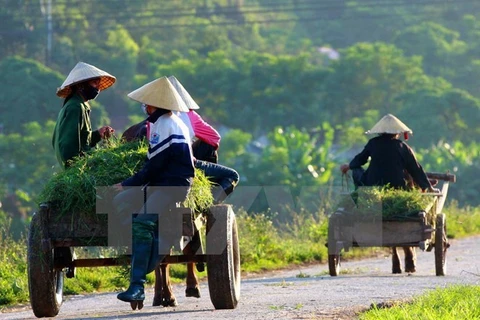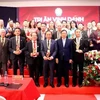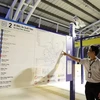 The 2016 report “Characteristics of the Vietnamese rural economy” was released at a workshop in Hanoi on November 7. (Photo: VNA)
The 2016 report “Characteristics of the Vietnamese rural economy” was released at a workshop in Hanoi on November 7. (Photo: VNA) Hanoi (VNA) – The 2016 report “Characteristics of the Vietnamese rural economy” was released in Hanoi on November 7, providing information collected from a 2016 rural household survey in 12 provinces of the country.
The report is based on a survey of 2,669 rural households in 12 provinces, namely Lao Cai, Phu Tho, Lai Chau, Dien Bien, Nghe An, Quang Nam, Khanh Hoa, Dak Lak, Dak Nong, Lam Dong, Long An and former Ha Tay.
Addressing the workshop unveiling the report, President of the Central Institute for Economic Management Nguyen Dinh Cung said Vietnam has harvested a number of economic achievements since it began the Doi moi (reform) process three decades ago. It is developing at a faster pace than many other lower-middle- and middle-income countries.
The survey is a rare repeated survey that looks into problems facing some regions and groups that are left behind, he added.
The report shows that access to official credit is an important tool to help eliminate poverty. However, the poorest and most vulnerable households usually encounter difficulties in accessing credit. About 28 percent of households had at least one loan while over 71 percent had no loan.
Cung said household businesses are important to rural livelihoods of Vietnam. Although they make up a small portion in terms of income, they receive considerable investment resources.
The success of household enterprises is closely linked with the wealth, educational level and ethnicity of the households. However, most of the small firms with few employees have informal business activities, he added.
Meanwhile, migration is still popular, especially in Quang Nam, Nghe An, Dak Lak and Dak Nong, and migrants’ destinations are Hanoi, Ho Chi Minh City, Dak Lak. Most of the migrants are men from poorer families in their communities.
The report also says that households in northern mountainous provinces like Lao Cai, Dien Bien and Lai Chau lag behind on a number of indicators of welfare such as poverty mobility, access to health education and other services.
The sustained economic growth over the last decade has led to significant improvements in the well-being of the people of Vietnam. More poor households are gaining access to government support and services to help lift them out of poverty. However, there remain significant disparities in welfare and access to resources across different household groups.
Director of the UN University World Institute for Development Economics Research (UNU-WIDER) Finn Tarp said to ensure Vietnam’s economic attainments are distributed equally, policy makers should pay more attention to narrowing this gap in the coming years and tackle inequalities to ensure that the poorest and most vulnerable groups won’t be left behind.-VNA
VNA























